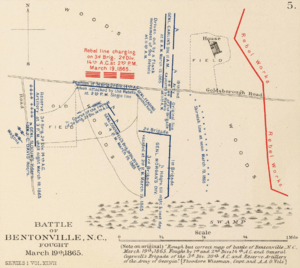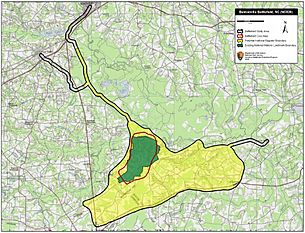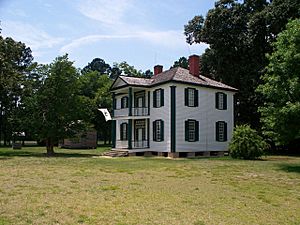Battle of Bentonville facts for kids
Quick facts for kids Battle of Bentonville |
|||||||
|---|---|---|---|---|---|---|---|
| Part of the Campaign of the Carolinas | |||||||
 Map of the Battle of Bentonville |
|||||||
|
|||||||
| Belligerents | |||||||
| Commanders and leaders | |||||||
| Units involved | |||||||
| Military Division of the Mississippi | Army of the South | ||||||
| Strength | |||||||
| 60,000 | 21,900 | ||||||
| Casualties and losses | |||||||
| 1,527 total
(194 killed,
1,112 wounded, 221 missing/captured) |
2,606 total
(239 killed,
1,694 wounded, 673 missing/captured) |
||||||
The Battle of Bentonville was a major fight during the American Civil War. It happened in Johnston County, North Carolina, from March 19 to 21, 1865. This battle was the last big clash between the armies of Union General William Tecumseh Sherman and Confederate General Joseph E. Johnston.
General Sherman's army was marching towards Goldsboro. His army was split into two parts. One part, led by General Henry Warner Slocum, met Johnston's Confederate soldiers. On the first day, the Confederates attacked and pushed back some Union troops. But the rest of Sherman's army held their ground.
The next day, Sherman sent more soldiers to the battle. There was only small fighting. On the third day, a Union division tried to attack the Confederates from behind. The Confederates fought them off. That night, General Johnston decided to pull his army away from the battlefield.
The Union army was much stronger and the Confederates lost many soldiers. Because of this, General Johnston surrendered to General Sherman about a month later. This surrender, along with General Robert E. Lee's surrender on April 9, meant the war was almost over.
Contents
Why Did the Battle of Bentonville Happen?
After his famous "Sherman's March to the Sea" through Georgia, General William T. Sherman led his army north. He marched through South Carolina and into North Carolina. His goal was to destroy Confederate supply lines.
In early 1865, Sherman's army caused a lot of damage in South Carolina. On March 8, Union soldiers entered North Carolina. Confederate forces tried to gather their troops to stop them. Sherman divided his army into two groups. One group was the Left Wing, led by General Henry W. Slocum. The other was the Right Wing, led by General Oliver O. Howard. Both groups marched towards Goldsboro. The Union leaders did not expect much resistance from the Confederates.
On February 23, Confederate General Robert E. Lee ordered General Johnston to take charge of all Confederate units in the Carolinas, Georgia, and Florida. Johnston was told to "concentrate all available forces and drive back Sherman." Johnston gathered several Confederate armies. He called this combined force the Army of the South. Confederate maps wrongly showed that Sherman's two army groups were far apart. Johnston planned to attack Slocum's group before it could join with the rest of Sherman's army. He planned the attack for March 19.
Who Fought in the Battle?
| Opposing commanders at Bentonville |
|---|
|
The main commanders were:
- For the Union: Major General William T. Sherman
- For the Confederates: General Joseph E. Johnston and General Braxton Bragg
Sherman's army had about 60,000 soldiers. Johnston's army had about 21,900 soldiers.
Union Forces
The Union army was made up of the Military Division of the Mississippi. This included the Army of Georgia and the Army of the Tennessee.
Confederate Forces
The Confederate army was called the Army of the South. It included soldiers from the Army of Tennessee and other units.
What Happened During the Battle?
The Confederate attack began on March 19. General Slocum's Union soldiers were marching on the Goldsboro Road. General Johnston's Confederates attacked them. Slocum thought he was only fighting a small group of enemy cavalry. He did not realize he was facing Johnston's entire army. Sherman also did not think Johnston would fight with the Neuse River behind him. So, Slocum first told Sherman that he only needed a little help.
Slocum tried to push the Confederates away with an attack. But this attack was stopped. Slocum then set up his soldiers in a defensive line. He wanted to hold off the Confederates until the rest of his army arrived. The Union soldiers did not build very strong defenses. There was also a weak spot in the middle of their line.
It looked like a picture and at our distance was truly beautiful ... But it was a painful sight to see how close their battle flags were together, regiments being scarcely larger than companies and a division not much larger than a regiment should be.
Around 3 p.m., Confederate soldiers attacked the Union left side. They pushed the Union line back. They almost captured a Union general. The Confederates attacked from three sides. But their attacks were not well-coordinated. So, they could not completely break the Union line. After a fierce fight, more Union soldiers arrived. They stopped the Confederate attack. Fighting continued into the night. The Confederates tried to push the Union line back but failed. Around midnight, the Confederates went back to their starting positions and began digging trenches.
Slocum had asked Sherman for help. General Howard's Union soldiers arrived late on March 20. They set up on Slocum's right side. Johnston moved his Confederate soldiers to face them. Only small skirmishes happened that day. Johnston stayed on the battlefield. He said he was there to remove his wounded soldiers. But he might have hoped Sherman would attack again.
On March 21, Union General Joseph A. Mower asked to scout ahead. Instead, he launched a big attack on the Confederate left side. Mower's soldiers got very close to a key bridge. But Sherman quickly ordered them to pull back. Later, Sherman said this was a mistake. He felt he missed a chance to end the war right there. Among the Confederate soldiers who died was General Hardee's 16-year-old son, Willie.
What Was the Result of the Battle?
The Confederates lost about 2,600 soldiers in total. This included 239 killed, 1,694 wounded, and 673 missing. About half of these losses were from the Army of Tennessee. The Union army lost 1,527 soldiers. This included 194 killed, 1,112 wounded, and 221 missing.
I can do no more than annoy him. I respectfully suggest that it is no longer a question whether you leave present position; you have only to decide where to meet Sherman. I will be near him.
The wounded soldiers were treated at the John Harper house. Many unknown Confederate soldiers were buried in a mass grave nearby.
During the night of March 21, Johnston pulled his army back across Mill Creek. He burned the bridge behind them. The Union army did not realize the Confederates had left until it was too late. Sherman did not chase them. He continued his march to Goldsboro. There, he met up with other Union forces. After resting, Sherman planned to go to Petersburg, Virginia. However, General Lee surrendered on April 9. Then, General Johnston surrendered to Sherman on April 26 at the Bennett Place in North Carolina.
After the Battle of Bentonville, the Confederate army gathered near the Everitt P. Stevens House. The last "Grand Review" of the army happened there on April 6, 1865. Generals William J. Hardee, Joseph E. Johnston, and Governor Zebulon Baird Vance were present.
Visiting the Battlefield Today
The place where the battle happened is now the Bentonville Battleground State Historic Site. It was named a National Historic Landmark in 1996. The park opened in 1965. It covers about 130 acres (0.53 km2) of the battlefield. There is a visitor's center next to the restored Harper House. This house was used as a hospital for Union soldiers during the battle. You can take tours inside the Harper House. Other groups also own parts of the battlefield.
Images for kids
See also
 In Spanish: Batalla de Bentonville para niños
In Spanish: Batalla de Bentonville para niños





